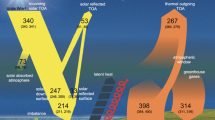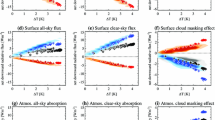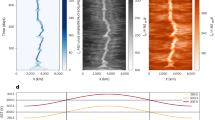Abstract
Using data for 3 days in the Cooperative Atmosphere-Surface Exchange Study 1997 field experiment that are analyzed in LeMone et al. (Boundary-Layer Meteorol 104:1–52, 2002, hereafter L2002), it is shown that direct radiative heating can have a significant role in warming the nearly cloudless fair-weather convective boundary layer (CBL). Radiative heating becomes especially important in the presence of aerosols in the CBL, with a moist layer above the CBL also contributing. Not only does inclusion of radiative heating help “close” their potential-temperature budgets, but it affects entrainment estimates. Combined, radiative heating rates are of the order of 0.2 K h−1, based on calculations using the Rapid-Radiative Transfer Model for general circulation models (RRTMG) code in a single-column version of the Advanced Research Weather Research and Forecasting model and estimates of aerosol heating published in L2002. Our current estimates of clear-air direct radiative heating differ from the estimates in L2002 because the surface skin temperature was not included in the earlier calculations. Upwelling and downwelling longwave radiation computed using the RRTMG code agrees with aircraft measurements within 10–15 W m−2.











Similar content being viewed by others
Notes
Note that the clear-air heating values in Table VII of L2002 were added to the computed aerosol heating, so that the columns labeled “aerosol warming” should have read “clear-air plus aerosol warming”; for correct values, see our Table 2.
U.S. National Science Foundation; U.S. National Oceanographic and Atmospheric Administration.
The other sites only sampled net radiation and downwelling shortwave radiation rather than upwelling and downwelling shortwave and longwave radiation.
References
Angevine WM (1999) Entrainment results including advection and case studies from the Flatland boundary layer experiments. J Geophys Res 103(D24):30947–30963
Angevine WM, Grimsdell AW, McKeen SA (1998) Entrainment results from the Flatland boundary layer experiments. J Geophys Res 103(D12):13689–13701
Ball FK (1960) Control of inversion height by surface heating. Q J Roy Meteorol Soc 86:483–494
Barbaro E, Vilà-Guerau de Arellano J, Krol MC, Holtslag AAM (2013) Impacts of aerosol shortwave radiation absorption on the dynamics of an idealized convective atmospheric boundary layer. Boundary-Layer Meteorol 148:31–49
Barr AG, Betts AK (1997) Radiosonde boundary layer budgets over a boreal forest. J Geophys Res 102(D24):29205–29212
Barr AG, Betts AK, Desjardins RL, MacPherson JI (1997) Comparison of regional surface fluxes from boundary layer budgets and aircraft measurements above boreal forest. J Geophys Res 102(D24):29213–29218
Betts AK, Barr AG (1996) First international satellite land surface climatology field experiment 1987 sonde budget revisited. J Geophys Res 101(D18):23285–23288
Betts AK, Desjardins RL, MacPherson JI, Kelly RD (1990) Boundary-layer heat and moisture budgets from FIFE. Boundary-Layer Meteorol 50:109–137
Chen F, Yates DN, Nagai H, LeMone M, Ikeda K, Grossman RL (2003) Land-surface heterogeneity in the Cooperative Atmosphere Surface Exchange Study (CASES-97). Part I: comparing modeled surface flux maps with surface-flux tower and aircraft measurements. J Hydrometeorol 4:196–218
Clarke RH (1970) Observational studies in the atmospheric boundary layer. Q J Roy Meteorol Soc 96:94–114
Conzemius RJ, Fedorovich E (2006) Dynamics of sheared connective boundary layer entrainment. Part II. Evaluation of bulk model predictions of entrainment flux. J Atmos Sci 63:1179–1199
Coulter R, Holdridge DH (1998) A procedure for the automatic estimation of mixed layer height. In: Proceedings of the 8th atmospheric radiation measurement (ARM) program science team meeting, Tucson, Dept of Energy Office of Energy Research, pp 177–180
Deardorff JW (1974) Three-dimensional numerical study of the height and mean structure of a heated planetary boundary layer. Boundary-Layer Meteorol 7:81–106
Edwards JM (2009a) Radiative processes in the stable boundary layer: part I. Radiative aspects. Boundary-Layer Meteorol 131:105–126
Edwards JM (2009b) Radiative processes in the stable boundary layer: Part II. The development of the nocturnal boundary layer. Boundary-Layer Meteorol 131:127–146
Edwards JM, Basu S, Bosveld EC, Holtslag AAM (2014) The impact of radiation on the GABLS3 large-eddy simulation through the night and during the morning transition. Boundary-Layer Meteorol 152:189–211
Geiger R (1966) The climate near the ground, Revised edn. Harvard University Press, Cambridge
Gentine PG, Steeveveld GJ, Heusinkveld BG, Holtslag AAM (2018) Coupling between radiative flux divergence and turbulence near the surface. Q J Roy Meteorol Soc 144:2491–2507
Grossman RL (1992) Convective boundary layer budgets of moisture and sensible heat over an unstressed prairie. J Geophys Res 97:18425–18438
Grossman RL, Yates D, LeMone M, Wesely M, Song J (2005) Observed effects of horizontal surface temperature variations on the atmosphere over a Midwest watershed during CASES-97. J Geophys Res 110(D6):1–21
Kuettner JP (1974) General description and central program of GATE. Bull Am Meteorol Soc 55:712–719
Kuettner JP, Parker DE (1976) GATE: report on the field phase. Bull Am Meteorol Soc 57:11–27
LeMone MA, Grossman RL, Coulter RL, Wesley ML, Klazura GE, Poulos GS, Blumen W, Lundquist JK, Cuenca RH, Kelly SF, Brandes EA, Oncley SP, McMillen RT, Hicks BB (2000) Land-atmosphere interaction research, early results and opportunities in the Walnut River watershed in southeast Kansas: CASES and ABLE. Bull Am Meteorol Soc 81:757–779
LeMone MA, Grossman RL, McMillen RT, Liou K-N, Ou SC, McKeen S, Angevine W, Ikeda K, Chen F (2002) Late-morning warming and moistening of the convective boundary layer over the Walnut River watershed. Boundary-Layer Meteorol 104:1–52
LeMone MA, Grossman RL, Chen F, Ikeda K, Yates D (2003) Choosing the averaging interval for comparison of observed and modeled fluxes along aircraft transects over a heterogeneous surface. J Hydrometeorol 4:179–195
LeMone MA, Chen F, Alfieri JG, Tewari M, Geerts B, Miao Q, Grossman RL, Coulter RL (2007) Influence of land cover and soil moisture on the horizontal distribution of sensible and latent heat fluxes in southeast Kansas during IHOP_2002 and CASES-97. J Hydrometeorol 8:68–87
LeMone MA, Angevine WM, Bretherton CS, Chen F, Dudhia J, Fedorovich E, Katsaros KB, Lenschow DH, Mahrt L, Patton EG, Sun J, Tjernström M, Weil J (2019) 100 years of progress in boundary layer meteorology. Meteorol Monogr 59:Chapter 9
Liu C, Fedorovich E, Huang J, Hu X-M, Wang Y, Lee X (2019) Impact of aerosol shortwave radiative heating on entrainment in the atmospheric convective layer: a large-eddy simulation study. J Atmos Sci 76:785–799
Mann J, Lenschow DH (1994) Errors in airborne flux measurements. J Geophys Res 99(D7):14519–14526
Mlawer ES, Taubman J, Brown PD, Ionoco MJ, Clough SA (1997) Radiative transfer for inhomogeneous atmospheres: RRTM, a validated correlated-k model for the longwave. J Geophys Res 102(D4):16663–16682
Moeng C-H, Sullivan PP (1994) A comparison of shear- and buoyancy-driven boundary layer flows. J Atmos Sci 51:999–1022
Moores WH (1982) Direct measurements of radiative and turbulent flux convergences in the lowest 1000 m of the convective boundary layer. Boundary-Layer Meteorol 22:283–294
Nicholls S, LeMone MA, Sommeria G (1982) The simulation of a fair weather marine boundary layer in GATE. Q J Roy Meteorol Soc 108:167–190
Priestley CHB, Swinbank WC (1947) Vertical transport of heat by turbulence in the atmosphere. Proc Roy Soc 189:543–561
Raga GB, Castro T, Baumgardner D (2001) The impact of megacity pollution on local climate and implications for the regional environment of Mexico City. Atmos Environ 35:1801–1811
Riehl H, Yeh C, Malkus JS, LaSeur NE (1951) On the heat balance and maintenance of the circulation in the trades. Q J Roy Meteorol Soc 77:598–626
Santanello JA, Peters-Lidard CD, Kumar SV, Alonge C, Kao WK (2009) A modeling and observational framework for diagnosing local land-atmospheric coupling on diurnal time scales. J Hydrometeorol 10:577–599
Stamnes K, Tsay S-C, Wilcombe W, Jaraweera K (1988) Numerically stable algorithm for discrete-ordinate method radiative transfer in multiple scattering and emitting layered media. Appl Opt 12:2502–2509
Steeneveld GJ, Wokke MJJ, Groot Zwaaftlink CD, Pijlman S, Heusinkveld BG, Jacobs AFG, Holtslag AAM (2010) Observations of the radiation divergence in the surface layer and its implication for its parameterization in numerical weather prediction models. J Geophys Res 115(D6):1–13
Stull RB (1988) An introduction to boundary layer meteorology. Kluwer Academic Press, Dordrecht
Acknowledgements
Radiative heating profiles were evaluated through comparison with offline runs of the Fu–Liou–Gu radiation code by Cenlin He of NCAR; both he and M. LeMone benefitted from advice and comments by Yu Gu of UCLA. Aerosol heating profiles in Table 2 were supplied by Stuart McKeen (NOAA, personal communication, 2000). Data compilations by Kyoko Ikeda (NCAR) were invaluable in reconstructing surface fluxes and aircraft flux profiles, so that we could replicate the flux divergences in the L2002 budgets. We also wish to acknowledge the staff/participants from the NOAA Atmospheric Turbulence and Diffusion Division, the University of Wyoming, Argonne National Laboratory and NCAR’s Environmental Observations Laboratory staff for collection, documentation, and processing of the data, responding to our many questions, and ultimately making the data available online. Conversations with Larry Oolman of University of Wyoming and Donald Lenschow of NCAR informed our evaluation of near-surface aircraft measurements. Finally, we wish to thank the three reviewers for their helpful and incisive comments. LeMone and Dudhia are supported by NCAR, which is supported by the National Science Foundation. Angevine is supported by the NOAA Chemical Sciences Laboratory.
Author information
Authors and Affiliations
Corresponding author
Additional information
Publisher's Note
Springer Nature remains neutral with regard to jurisdictional claims in published maps and institutional affiliations.
Margaret A. LeMone and Jimy Dudhia: NCAR is sponsored by the National Science Foundation.
Rights and permissions
About this article
Cite this article
LeMone, M.A., Angevine, W.M. & Dudhia, J. The Role of Radiation in Heating the Clear-Air Convective Boundary Layer: Revisiting CASES-97. Boundary-Layer Meteorol 178, 341–361 (2021). https://doi.org/10.1007/s10546-020-00577-y
Received:
Accepted:
Published:
Issue Date:
DOI: https://doi.org/10.1007/s10546-020-00577-y




